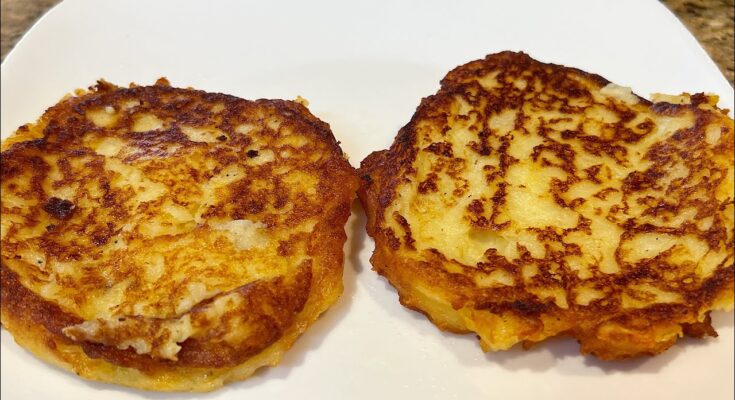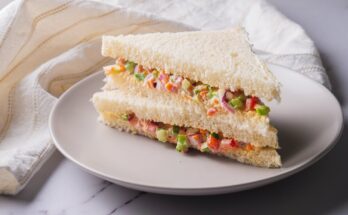Potato Cake Recipe: Potato cakes are golden, crispy, and savory delights made primarily from mashed or grated potatoes mixed with herbs, seasonings, and sometimes a little flour or egg for binding. These little patties are fried until crispy on the outside and soft and fluffy on the inside. They’ve been a favorite in kitchens around the world—whether you call them potato fritters, latkes, or simply potato pancakes.
They’re versatile too. You can serve them as a hearty breakfast, a satisfying side dish, or even a standalone snack. Some versions lean toward creamy and cheesy, while others keep it lean and seasoned. What makes potato cakes especially popular is how they can transform yesterday’s leftovers into today’s comfort food.
Potato cakes are not just quick and easy to whip up, but they also hit that sweet spot between crunchy and soft. And let’s be honest—who doesn’t love the idea of a golden-brown potato cake fresh from the skillet?
Why You’ll Love This Recipe
Here’s the thing about this potato cake recipe—it’s everything you want it to be. Easy? Check. Crispy? Check. Delicious? Double check. Whether you’re cooking for your family or just looking to make something special for yourself, this recipe is foolproof. You don’t need fancy ingredients or equipment, and the result is always mouthwatering.
You’ll love how adaptable this recipe is. Want to add cheese? Go ahead. Got some green onions or bacon bits lying around? Throw them in. It’s one of those base recipes that welcomes creativity. Plus, it’s kid-friendly, budget-friendly, and perfect for making ahead and freezing.
And if you’ve got leftover mashed potatoes sitting in the fridge, this recipe turns them into something magical. No waste, all taste!
Ingredients You’ll Need
Fresh Ingredients List
Let’s start by gathering everything you need. Here’s a simple, classic version of potato cakes:
- 2 cups mashed potatoes (freshly made or leftover)
- 1 egg
- 1/4 cup all-purpose flour
- 1/4 cup grated cheddar cheese (optional but recommended)
- 1/4 small onion, finely chopped
- 2 tablespoons chopped green onions or parsley
- Salt and black pepper to taste
- 1/2 teaspoon garlic powder (optional)
- 2 tablespoons butter or oil for frying
These ingredients are easy to find and likely already in your kitchen. You can tweak them to fit your flavor profile or dietary preferences.
Substitution Tips and Tricks
No cheddar? Use mozzarella, parmesan, or skip the cheese altogether. Want a gluten-free version? Swap flour with almond flour or gluten-free breadcrumbs. Watching your calories? Try baking instead of frying, or use a non-stick pan with minimal oil.
Don’t have green onions? Regular onions work just fine. You can even add spices like paprika, cayenne, or dried herbs to elevate the flavor. And if you’re vegan, skip the egg and use a flaxseed egg substitute—just mix one tablespoon of ground flaxseed with three tablespoons of water and let it sit for a few minutes to thicken.
Tools and Kitchenware
Basic Tools Required
The best part about this potato cake recipe? You don’t need any fancy kitchen gear. Just grab:
- A mixing bowl
- A spoon or spatula
- A non-stick skillet or frying pan
- Measuring cups and spoons
- A spatula for flipping
It’s that simple. If you’ve got a cheese grater and a knife, you’re ready to go.
Helpful Additions for Cooking Ease
While not essential, these extras can make the process smoother:
- Ice cream scoop – for evenly portioned cakes
- Cast iron skillet – for that perfectly crisp outer layer
- Food processor – if you’re using raw grated potatoes instead of mashed
- Cooling rack – to keep cakes crispy after frying
All set with the tools? Great, let’s move on to the fun part—making those delicious potato cakes.
Step-by-Step Cooking Instructions
Step 1 – Preparing the Potatoes
If you’re starting from scratch with fresh potatoes, peel and boil about 3-4 medium potatoes until they’re fork-tender. Drain and mash them with a pinch of salt. Let them cool to room temperature before mixing in the other ingredients. If you’re using leftovers, just bring them to room temp or warm slightly to soften.
Smooth mashed potatoes work best here, but it’s okay if they’re a bit chunky—it adds texture.
Step 2 – Mixing the Ingredients
In a large mixing bowl, combine your mashed potatoes, egg, flour, cheese, onions, herbs, and spices. Mix well until everything is evenly distributed. The mixture should be firm enough to hold its shape but not too dry. If it feels too wet, add a tablespoon of flour. Too dry? Add a splash of milk or another egg.
Pro tip: let the mixture sit for 5-10 minutes to allow the flour to absorb moisture. This helps in shaping and frying.
Step 3 – Shaping the Cakes
Using your hands or an ice cream scoop, portion out the mixture and form small patties about 2.5 to 3 inches wide. Press them gently—don’t overwork them.
Lay them on a plate or baking sheet lined with parchment paper. You can refrigerate them for 15-20 minutes to help them firm up before frying. This step is optional but highly recommended if you want neat, golden cakes that don’t fall apart.
Step 4 – Frying to Perfection
Heat your butter or oil in a skillet over medium heat. Once hot, add the patties, leaving space between each one. Don’t overcrowd the pan.
Cook for 3-5 minutes on each side until golden brown and crispy. Flip them gently with a spatula. You’ll know they’re ready when the crust is a deep golden color and the edges look crunchy.
Transfer to a cooling rack or paper towel-lined plate to drain excess oil.
Serving Suggestions
Perfect Pairings and Toppings
Once your potato cakes are crispy and golden, it’s time to plate them up and serve. But how do you make them shine even brighter? Easy—pair them with tasty toppings and side dishes that elevate the whole experience.
Start with the basics:
- Sour cream or Greek yogurt: These add a cool, creamy contrast to the hot, crispy cakes.
- Applesauce: This is a classic option in some European traditions—sweet and savory in one bite!
- Chutneys or salsa: Want some heat or a tangy kick? A dollop of spicy tomato chutney or zesty salsa works beautifully.
- Poached or fried eggs: Place an egg on top for a breakfast-style dish that’s satisfying and delicious.
Now, let’s get creative. Serve them with:
- Grilled vegetables like zucchini, bell peppers, or mushrooms.
- A fresh salad with lemon vinaigrette to balance the richness of the cakes.
- Baked beans or lentils for a hearty, protein-rich combo.
- Roasted chicken or salmon to turn these humble cakes into a full-on dinner.
You can even treat them like sliders—use them as a base and stack on toppings like smoked salmon, avocado slices, or even pulled pork. It’s all about playing with flavors and textures.
Meal Ideas with Potato Cakes
Potato cakes aren’t just side dishes—they can star in meals across the board:
- Breakfast: Serve with scrambled eggs, bacon, and toast.
- Lunch: Pair with a crisp green salad and a drizzle of balsamic glaze.
- Dinner: Stack a few cakes, top with sautéed spinach, and add a protein like grilled steak or fish.
- Snack Time: Serve warm with dipping sauces like ranch, chipotle mayo, or tzatziki.
No matter how you serve them, potato cakes are bound to please. Their crispy crust and creamy interior make them a comforting classic you’ll crave again and again.
Storage and Reheating Tips
Refrigeration Guidelines
Got leftovers? Lucky you! Potato cakes store wonderfully, and they reheat just as well. Let the cakes cool completely before storing. This prevents condensation, which can make them soggy.
- In the fridge: Store in an airtight container, layering parchment paper between them to avoid sticking. They’ll keep well for 3 to 4 days.
- Pro tip: If you plan to reheat them soon, you can keep them on a plate covered loosely with foil or plastic wrap to keep the texture.
To reheat:
- Stovetop: Add a bit of oil to a skillet and warm them over medium heat until crispy again.
- Oven: Preheat to 350°F (175°C) and bake for 10-15 minutes on a baking tray.
- Microwave: Not recommended—it softens the crust—but if you’re in a rush, 1 minute on high works.
Freezing Instructions
Want to make a big batch and save some for later? Here’s how to freeze them properly:
- Let them cool completely.
- Place them in a single layer on a baking sheet and freeze for about 1 hour.
- Once solid, transfer to a freezer-safe bag or container, separating layers with parchment paper.
- Label with the date—they’ll keep well for up to 2 months.
To reheat from frozen, no need to thaw. Just bake at 375°F (190°C) for 15-20 minutes or pan-fry over low-medium heat until heated through.
Variations of Potato Cake
Cheesy Potato Cakes
If you’re a cheese lover, you’re in for a treat. Adding cheese to your potato cakes not only enhances flavor but also adds gooey texture that makes every bite irresistible. Cheddar is the most popular option, but feel free to experiment with mozzarella, parmesan, or even pepper jack for a spicy kick.
To make cheesy potato cakes:
- Mix 1/2 to 1 cup of shredded cheese directly into the potato mixture before forming the cakes.
- Want a surprise in every bite? Stuff a cube of cheese inside each cake for a melty center.
- Combine cheeses for depth—cheddar for sharpness, mozzarella for meltiness, and parmesan for saltiness.
Cheesy potato cakes pair beautifully with tomato-based sauces, creamy dressings, or even just a sprinkle of herbs on top. Serve these with a tomato soup or a green salad for a cozy, comforting meal.
Vegan Potato Cakes
Going plant-based? No problem—potato cakes are easy to veganize without sacrificing taste or texture.
Here’s how:
- Replace the egg with a flax egg (1 tbsp ground flaxseed + 3 tbsp water, let sit 10 mins).
- Use plant-based milk or oil if you need to adjust moisture.
- Add veggies like grated carrots, zucchini, or peas for color and nutrition.
- Season with herbs, garlic, onion, and nutritional yeast to mimic cheesy flavors.
Vegan potato cakes are delicious with avocado, spicy hummus, or dairy-free yogurt sauces. You can even serve them as vegan burger patties or sandwich fillers. They’re hearty, healthy, and loaded with flavor.
Tips for Perfect Potato Cakes Every Time
Avoiding Common Mistakes
Even a simple recipe like potato cakes can go sideways if you’re not careful. Here are some frequent mistakes and how to avoid them:
- Too much moisture: If your mixture is too wet, it won’t hold together. Fix it with a bit more flour or breadcrumbs.
- Over-flipping: Let the cakes cook long enough to form a crust before flipping. If they’re sticking, they’re not ready.
- Crowding the pan: Give them space to cook evenly and crisp up. Cook in batches if needed.
- Undercooked centers: Keep the heat on medium, not high. Too hot and the outside burns before the inside warms.
Texture and Flavor Tips
For that restaurant-quality finish, keep these in mind:
- Use cold mashed potatoes for better structure.
- Mix in cornstarch or potato starch instead of flour for extra crispiness.
- Add butter to the skillet for a richer flavor and golden color.
- Try coating the cakes lightly in breadcrumbs or cornmeal before frying for an extra crunchy crust.
Want next-level flavor? Sprinkle a bit of finishing salt or parmesan right after cooking while they’re still hot. The result? Irresistible!
Nutritional Information
Calories and Macros
Here’s an approximate nutritional breakdown per medium-sized potato cake (standard non-cheesy version):
- Calories: 120-150 kcal
- Carbohydrates: 20g
- Protein: 3g
- Fat: 4-6g
- Fiber: 1-2g
These numbers can vary based on ingredients and portion size. Adding cheese, bacon, or frying in more oil will increase the calorie count. On the flip side, using low-fat milk or baking instead of frying can make them lighter.
Health Benefits of Potatoes
Potatoes often get a bad rap, but they’re actually pretty nutritious:
- Rich in potassium, even more than bananas.
- Good source of vitamin C, especially with the skin on.
- Provide fiber, especially if you mix in veggies or use whole ingredients.
- Naturally gluten-free and satisfying, making them a great base for meals.
When prepared right, potato cakes can fit into almost any diet—from gluten-free to vegetarian and even low-fat versions. They’re satisfying without being heavy and are perfect for both indulgent meals and light bites.
FAQs about Potato Cake Recipe
1. Can I use instant mashed potatoes for this recipe?
Yes, though fresh or leftover homemade mashed potatoes give better flavor and texture. Just make sure instant mash isn’t too runny.
2. What’s the best oil for frying potato cakes?
Vegetable oil or canola oil are neutral and good for high heat. For extra flavor, try a mix of butter and oil.
3. Can I bake potato cakes instead of frying?
Absolutely! Bake at 400°F (200°C) for 15-20 minutes on a lined baking sheet, flipping halfway through.
4. How do I prevent my potato cakes from falling apart?
Make sure the mixture isn’t too wet. Use flour or breadcrumbs to bind, and let the cakes chill before frying.
5. Are potato cakes gluten-free?
They can be! Just swap all-purpose flour with a gluten-free flour blend or potato starch.
Conclusion
Potato cakes are a timeless, crowd-pleasing dish that brings joy to any table. Whether you’re cooking from scratch or using up leftovers, these crispy golden patties are a versatile solution to mealtime indecision. With just a few simple ingredients and steps, you get a dish that can be as humble or gourmet as you like.
From breakfast plates to party appetizers, potato cakes never fail to impress. Make them cheesy or vegan, spicy or herby—they adapt to your flavor mood. And don’t forget, they’re perfect for freezing, meal prepping, or just making your next brunch extra special.
So grab those spuds and get cooking. Your taste buds will thank you.



